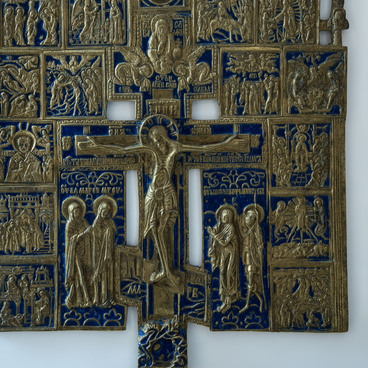The presented exhibit is a silver revetment for a waist-length image of the Almighty: silver covered most of the surface of the icon, leaving open only His face and hands. We see a slot in the revetment under the right hand raised in a blessing and under the left hand holding the opened Gospel of John (13:34) with the words “A new commandment I give to you, that you love one another; as I have loved you, that you also love one another”.
In the upper corners there are stamped overlays with the letters “IИС” (“Jesus”) and “ХРС” (“Christ”). Each letter is decorated with enamel that elegantly repeats the outline. There are also two superimposed inscriptions on the sides of the halo: “ГОСПОДЬ” (“Lord”) and “ВСЕДЕРЖ” (“Almighty”) , with blue enamel filling the space between the letters. The top and side parts are decorated with floral décor in turquoise-blue and white enamel.
The elaborate halo was also made separately and attached to the revetment (fixed on the reverse side with rivets). The surface of the halo features a pattern of twisted wires forming partitions, between which enamel of different colors is placed. The rim of the halo is arranged in the form of alternating rosettes and lilies. The cruciform halo has three segments with the red letters on a blue field — “Ὁ”, “Ὤ” and “N” (“He Who Is”). The remaining four segments of the inner circle of the halo (with the letters) are densely filled with a multicolored floral pattern.
The garments of Christ — the chiton and the himation (cloak) — are skillfully depicted. The matte fibrous texture of this simple fabric is rendered by fine chasing. The himation is also made in this technique, but it plays a different role — it serves as a background for a convex embossed floral motif. The folds of the robes are beautifully made in high relief.
The highly professional work of the master (or
masters) on the metal and enameled parts resulted in a bright, truly precious
piece that pleases the eye. A revetment (also called a riza or oklad) is a type
of icon decoration that existed for centuries in Russia, and before that in
Romania (the Roman Empire that after its fall was called Byzantium), from where
this art, along with icon painting and the tradition of icon worship in
general, was borrowed by the Russians.


